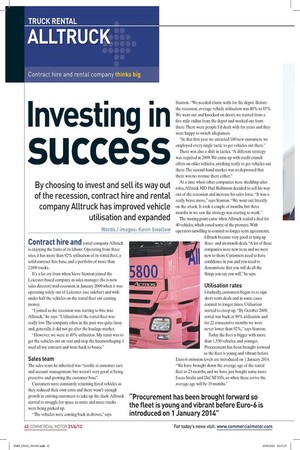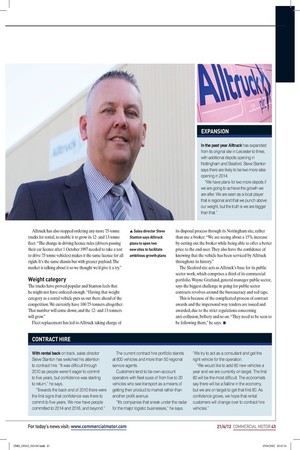Investing in
Page 34

Page 35

If you've noticed an error in this article please click here to report it so we can fix it.
success
By choosing to invest and sell its way out of the recession, contract hire and rental company Alltruck has improved vehicle utilisation and expanded
Words / images: Kevin Swallow
Contract hire and rental company Alltruck is enjoying the fruits of its labour. Operating from three sites, it has more than 92% utilisation of its rental fleet, a solid contract hire base, and a portfolio of more than 2,000 trucks.
It’s a far cry from when Steve Stanton joined the Leicester-based company as sales manager (he is now sales director) mid-recession in January 2009 when it was operating solely out of Leicester (see sidebar) and with under half the vehicles on the rental fleet out earning money.
“I joined as the recession was starting to bite into Alltruck,” he says. “Utilisation of the rental fleet was really low. The company ethos in the past was quite fussy and, generally, it did not go after the haulage market.
“However, we were at 49% utilisation. My remit was to get the vehicles out on rent and stop the haemorrhaging. I used all my contacts and went back to basics.”
Sales team
The sales team he inherited was “terrific at customer care and account management, but weren’t very good at being proactive and growing the customer base”.
Customers were constantly returning hired vehicles as they reduced their own costs and there wasn’t enough growth in existing customers to take up the slack. Alltruck started to struggle for space as more and more trucks were being parked up.
“The vehicles were coming back in droves,” says Stanton. “We needed elastic walls for the depot. Before the recession, average vehicle utilisation was 80% to 85%. We went out and knocked on doors; we started from a five-mile radius from the depot and worked out from there. There were people I’d dealt with for years and they were happy to switch allegiances.
“In that first year we attracted 100 new customers, we employed every single tactic to get vehicles out there.” There was also a shift in tactics. “A different strategy was required in 2009. We came up with credit crunch offers on older vehicles, anything really to get vehicles out there. The second-hand market was so depressed that there was no avenue there either.” At a time when other companies were shedding sales roles, Alltruck MD Paul Robinson decided to sell his way out of the recession and increase his sales force. “It was a really brave move,” says Stanton. “We went out literally on the attack. It took a couple of months, but three months in we saw the strategy was starting to work.” The turning point came when Alltruck sealed a deal for 40 vehicles, which eased some of the pressure. With operators unwilling to commit to longer-term agreements, Alltruck became very good at tying up threeand six-month deals. “A lot of these companies were new to us and we were new to them. Customers need to have confidence in you and you need to demonstrate that you will do all the things you say you will,” he says.
Utilisation rates
Gradually, customers began to re-sign short-term deals and in some cases commit to longer times. Utilisation started to creep up. “By October 2009, rental was back at 90% utilisation and for 22 consecutive months we were never lower than 92%,” says Stanton.
Today the fleet is bigger with more than 1,550 vehicles, and younger. Procurement has been brought forward so the fleet is young and vibrant before Euro-6 emission levels are introduced on 1 January 2014. “We have brought down the average age of the rental fleet to 23 months, and we have just bought some more Iveco Stralis and Daf XF105s, so when these arrive the average age will be 19 months.” Alltruck has also stopped ordering any more 7.5-tonne trucks for rental, to enable it to grow its 12and 13-tonne fleet. “The change in driving licence rules (drivers passing their car licence after 1 October 1997 needed to take a test to drive 7.5 tonne vehicles) makes it the same licence for all rigids. It’s the same chassis but with greater payload. The market is talking about it so we thought we’d give it a try.”
Weight category
The trucks have proved popular and Stanton feels that he might not have ordered enough. “Having that weight category as a rental vehicle puts us out there ahead of the competition. We currently have 100 7.5-tonners altogether. That number will come down, and the 12and 13-tonners will grow.” Fleet replacement has led to Alltruck taking charge of its disposal process through its Nottingham site, rather than use a broker. “We are seeing about a 15% increase by cutting out the broker while being able to offer a better price to the end-user. They also have the confidence of knowing that the vehicle has been serviced by Alltruck throughout its history.” The Sleaford site acts as Alltruck’s base for its public sector work, which comprises a third of its commercial portfolio. Wayne Gratland, general manager public sector, says the biggest challenge in going for public sector contracts revolves around the bureaucracy and red tape.
This is because of the complicated process of contract awards and the impersonal way tenders are issued and awarded, due to the strict regulations concerning anti-collusion, bribery and so on. “They need to be seen to be following them,” he says. n











































